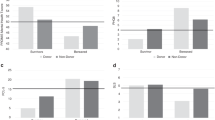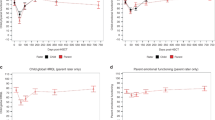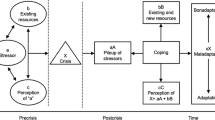Abstract
Few studies have examined the effect of parental BMT on the family and less is known regarding the impact on children. The purpose of this prospective study was to increase understanding of children’s adaptation to the stress of parental BMT across a 12-month trajectory. Data were obtained from 61 children ages 10–18 before parental transplant, during parental hospitalization, 1, 4 , 8 and 12 months post BMT. Mixed linear modeling was used to analyze longitudinal data from children nested within families. Analyses examined change in child emotional adaptation, points of greatest vulnerability throughout the BMT trajectory and the impact of theoretically relevant variables on their adaptation. Children’s emotional adaptation became significantly more positive over time, although their level of distress remained above the norm. Pre-transplant was the period of greatest emotional distress. Negative self-esteem, disruption within the family structure, use of disengagement coping and the mother as transplant recipient were associated with more negative adaptation. Further research is needed to fully understand the effects of parental BMT on children. However, these findings point to the importance of considering the adaptation of children and its implications for the development of preventive family interventions for this vulnerable population.
This is a preview of subscription content, access via your institution
Access options
Subscribe to this journal
Receive 12 print issues and online access
$259.00 per year
only $21.58 per issue
Buy this article
- Purchase on Springer Link
- Instant access to full article PDF
Prices may be subject to local taxes which are calculated during checkout

Similar content being viewed by others
References
Statistical Center for International Blood and Marrow Transplant Research 2010 Available from: http://www.cibmtr.org.
Moore CW, Rausch PK . Addressing Parenting concerns of bone marrow transplant patients: Opening (and closing) Pandora's box. Bone Marrow Transplant 2006; 38: 775–782.
Zabora JR, Smith ED, Baker F, Wingard JP, Curbow B . The family: The other side of bone marrow transplantation. J Psychosoc Oncol 1992; 10: 35–46.
Baker F, Zabora J, Polland A, Wingard J . Reintegration after bone marrow transplantation. Cancer Pract 1999; 7: 190–197.
Holland CM . The Effects of Parental Life-Threatening Illness on Children's Adjustment. Dissertation 1997. West Virginia University, Morgantown, WV.
Huizinga G, Visser A, van der Graff W, Hoekstra H, Hokestra-Weebers J . Stress response symptoms in adolescent and young adult children of parents diagnosed with cancer. Eur J Cancer 2005; 41: 288–295.
Northouse L . The impact of cancer on the family. Int J Psychiatry in Med 1984; 14: 215–242.
Pedersen S, Revensen T . Parental illness, family functioning, and adolescent well-being: a family ecology framework to guide research. J Family Psychol 2005; 19: 404–409.
Roy R . Consequences of parental illness on children: a review. Soc Work Soc Sci Rev 1990; 2: 109–124.
Armistead LK, Klein K . Forehand R. Parental physical illness and child functioning. Cl Psychol Rev 1995; 15: 409–422.
Grant KE, Compas BE . Stress and anxious-depressed symptoms amongadolescents: Searching for mechanisms of risk. J Consult Cl Psychol Rev 1995; 63: 1015–1021.
Huizinga GA, van der Graff WTA, Visser A, Dijsktra J, Hoekstra-Weebers JEHM . Psychosocial consequences for children of a parent with cancer: a pilot study. Ca Nurs 2003; 26: 195–202.
Osborn T . The psychosocial impact of parental cancer on children and adolescents: a systematic review. Psycho-Oncol 2007; 16: 101–126.
Harris CA, Zakowski SG . Comparisons of distress in adolescents of cancer patients and controls. Psycho-Oncol 2003; 12: 173–182.
Watson M, St James-Roberts I, Ashley S, Tilney C, Brougham B, Edwards L . Factors associated with emotional and behavioral problems among school age children of breast cancer patients. Br J Cancer 2005; 94: 43–50.
Woods NF, Lewis FM . Women with chronic illness: their views of their families’ adaptation. Health Care Women Int 1995; 16: 135–148.
Grabiak BC, Bender C, Puskar K . The impact of parental cancer on the adolescent:an analysis of the literature. Psycho-Oncol 2007; 16: 127–137.
Minuchin S . Families and Family Therapy. Harvard University Press: Boston, MA, 1987.
Bowman G . Emotions and Illness. J Adv Nurs 2000; 34: 256–263.
Price J . The adaptive function of mood change. Br J Med Psychol 1996; 71: 465–477.
Connor-Smith J, Compas B, Wadsworth M, Thomson A, Salsman H . Responses to stress in adolescence: measurement of coping and involuntary responses. J Consult Cl Psychol 2000; 68: 976–992.
Baldwin SA, Hoffman JP . The dynamics of self-ersteem: A growth-curve analysis. J Youth Adolescence 2002; 31: 101–113.
Yabkiu ST, Axinn WG, Thornton A . Family integration and children's self-esteem. Am J Soc 1999; 104: 1494–1524.
Cox MJ, Paley B . Families as systems. Ann Rev Psychol 1997; 48: 243–267.
Moos RH, Moos BS . Family Environment Scale Manual: Development, Applications, and Research. Mind Garden Inc: Palo Alto, CA, 2002.
Parsons SK, Levy S, Supran SE, Kaplan SH . Health-related quality of life in pediatric bone marrow transplant survivors: according to whom? Int J Cancer (Suppl 12): 1999; 83: 46–51.
Landgraf JL, Abetz J . The CHQ User’s Manual, 1st edn. The Health Institute, New England Medical Center: Boston, MA, 1996.
Harris J . Family communication during the cancer experience. J Health Commun 2009; 14: 76–84.
Watson D, Clark LA . Manual for the Positive and Negative Affect Schedule—Expanded Form: The PANAS-X. University of Iowa: Iowa City, IA, 1994.
Verbeke G, Molenberghs G . Linear Mixed Models for Longitudinal Data. Springer: Verlag, NY, 2009.
Nelson E, While D . Children’s adjustment during the first-year of a parent’s cancer diagnosis. J Psychosocial Oncol 2002; 20: 15–36.
Lewis FM, Darby E . Adolescent adjustment and maternal breast cancer: A test of the ‘Faucet Hypothesis’. J Psychosocial Oncol 2003; 21: 81–104.
Acknowledgements
The study was funded by the American Cancer Society, RSGBP-05-012-01-CPPB. NRSA, National Institute for Nursing Research, 1F31NR01003.
Author information
Authors and Affiliations
Corresponding author
Ethics declarations
Competing interests
The authors declare no conflict of interest.
Rights and permissions
About this article
Cite this article
Spath, M., Fife, B., Monahan, P. et al. Children's emotional adaptation to parental BMT. Bone Marrow Transplant 48, 135–140 (2013). https://doi.org/10.1038/bmt.2012.93
Received:
Accepted:
Published:
Issue Date:
DOI: https://doi.org/10.1038/bmt.2012.93
Keywords
This article is cited by
-
Effect of family cohesion on symptom distress during hematopoietic stem cell transplantation
Supportive Care in Cancer (2022)
-
Preliminary efficacy of a brief family intervention to prevent declining quality of life secondary to parental bone marrow transplantation
Bone Marrow Transplantation (2017)



